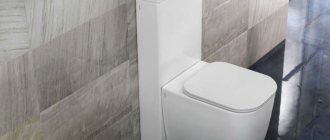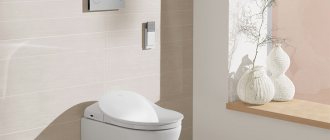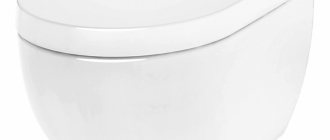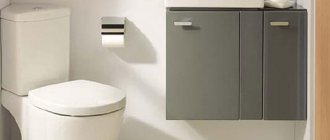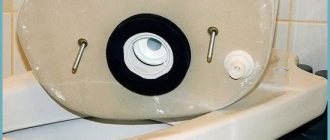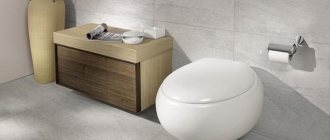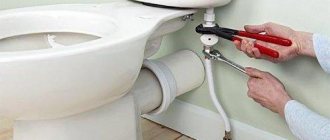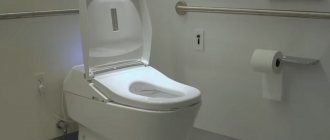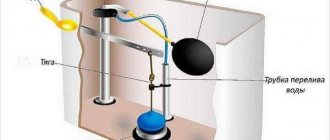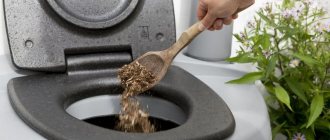The task of arranging a comfortable modern bathroom is usually one of the first things that owners consider when carrying out renovations in their apartment. An important component of the comfort created, of course, is a practical toilet that is harmoniously adapted to the interior. Indeed, in addition to its combination with surrounding objects, tiles, and the general concept of apartment renovation, it must be convenient to use, fully perform sanitary functions, and be reliable and durable household equipment.
General views
It is precisely taking into account the above characteristics that the owner undertaking a renovation should consider, as an option, a floor-standing toilet with a hidden cistern. Such products are installed on the decorative floor covering close to the wall. Such models successfully combine the properties of both classic floor and suspended installed frame products.
Attached toilets are equipped with flat flush cisterns connected to water supply and sewerage systems hidden behind a decorative wall. Therefore, attached-type equipment, being much cheaper than frame installations, becomes the optimal solution for rooms that combine a latrine and a bathroom.
In addition to performing the usual functions, the plumbing fixture can be supplemented with some convenient options.
- Microlift. A mechanism resembling a door closer. It smoothly lowers the lid, thereby protecting the product from mechanical damage and preventing the plastic from hitting the ceramic.
- Bidet. Faucet, to facilitate hygiene procedures, mounted on the bowl of a plumbing fixture.
Design
An attached or wall-mounted toilet is a fairly popular design. It is a monolithic plumbing device that has a streamlined shape. This toilet is suitable for both spacious bathrooms and small rooms.
Attached toilets are characterized by a hidden, slightly less often external, flush system.
Attention! Before installing a floor-standing toilet, pay attention to its outlet. It can be oblique, straight and vertical. Therefore, you need to purchase an attached toilet based on the toilet outlet in your toilet.
When you enter a bathroom that has a wall-mounted toilet, you will not see the cistern. This is his distinctive feature. Instead of a regular cistern, a flat device is installed, hidden behind the thickness of the wall.
In addition to all of the above, the attached toilet has a useful device - a microlift. It makes lowering the toilet lid smoother and quieter. Some call this function a closer, by analogy with the mechanisms installed on furniture doors.
Let's look at the advantages and disadvantages
A floor-mounted toilet with a hidden cistern exhibits its undeniable advantages in the following:
- its tank is filled and emptied during the pouring process practically without unnecessary noise, due to the acoustic decoupling through the decorative wall, as well as additional foam inserts;
- it significantly saves space in the toilet, both actually and visually, which is especially important for typical small-sized apartments;
- the interior of the bathroom adds aesthetic appeal;
- does not require an expensive supporting frame for installation, which also simplifies installation activities compared to a suspended installed model.
The weaknesses of the described devices are relative in comparison with other types of plumbing products for similar purposes:
- the cost of attached toilets is noticeably higher than classic floor-standing products;
- if it is necessary to replace the tank or repair communications, there will be inconvenience associated with dismantling the decorative partition;
- Unlike hanging models, they are rigidly fixed to the floor surface, which makes cleaning underneath them difficult, and also does not always meet design requirements.
Types of toilets without a tank
Drukshpullers are designed for two types of bowls: funnel-shaped and plate-shaped.
According to the method of installing the toilet, they are suitable for all types: floor-standing, console and attached.
Floor standing toilets
Manufacturers of external dryers for each model include instructions and a diagram for installing the system. The differences between them are in details, but the general principles of installation are the same:
- mark on the wall the place for cutting under the water pipe;
- lay a pipe to the connection point;
- from the floor level to the outlet of the adapter for connecting to the water supply should be about 1 m (950-1050 mm for a Grohe druckspuller, 890-1064 mm for a Schell);
- distance from the wall to the toilet flush hole - 140 mm;
- the drukspüller body is held in place by the transition pipe between it and the water pipe;
- to fix the drain pipe to the wall in the form of an elbow, one standard bracket is provided, holding it approximately in the middle;
- the third point of “support” of the system is the toilet drain hole.
Note. Hidden communication wiring can be carried out under the sheathing or in a plasterboard partition;
Installation of the pressure flush system takes place after finishing work is completed and the toilet is installed.
The sequence of work is as follows:
- The water is first drained - the pipeline is washed to remove any debris that may have entered during the work (a mechanical filter for coarse and fine cleaning in the water supply system must be required).
- Connect the dryer to the water supply.
- Cut the drain pipe so that it does not reach 20 mm from the drukspüller body. Insert the pipe into the toilet with its elbow.
- Install the adapter tube with a nut into the drain pipe from the side of the cut edge.
- Connect the drukshpuller with the adapter tube with a nut.
- Turn on the system, check it for leaks and operability.
- If necessary, remove the cover from the drainer and adjust the flush volume using the adjusting screw.
Materials used in the production of sanitary ware
Many brands use the same ceramics (porcelain and earthenware) for the manufacture of toilets with hidden tanks as for their other products. However, at the same time, there are products made from composite materials, natural stone or stainless steel.
- Porcelain toilets are durable, resistant to household cleaning agents, do not retain unpleasant odors, and are therefore easy to clean and disinfect.
- Earthenware products are cheaper than porcelain analogues, being a classic representative of products for bathrooms. The material for its production, just like for porcelain, is a mixture of ceramic clays with other mineral additives. However, earthenware firing occurs at lower temperatures. Despite the fact that earthenware toilets are covered with a protective glaze, like earthenware ones, their practicality is somewhat lower - over time, microcracks appear on them, they retain their original whiteness less well.
- Models made of composite materials have a wide range of colors, which is achieved by adding special pigments to the polymer concrete base.
- Toilets with a hidden tank , made of stainless steel, are easy to clean and are the most durable, including shock-resistant. “Stainless steel” prevents the growth of bacteria. Public toilets are often equipped with such plumbing fixtures.
- Models made of natural stone are bright representatives of the elite class, which is confirmed by their highest price. As a rule, they are produced according to special orders for the installation of expensive bathrooms and saunas.
Working with a tank built into the wall
It is quite difficult to change and repair fittings if the drainage container is hidden in the wall and disguised with finishing materials. To do this, you first have to dismantle the wall panel with the flush keys, then use a screwdriver to unscrew the frame on the hole in the wall. The partition is removed, after which access to the hidden water fittings is opened.
The water is shut off, after which the valves and other structural elements are dismantled. The breakdown is eliminated, after which the faulty plastic parts are replaced with new ones, and the mechanism is reassembled in the reverse order. Without experience, it is quite difficult to correctly assemble the components, so it is better to entrust hidden mechanisms to a specialist. Such fittings are easy to damage, and to completely replace the container you will have to dismantle the decorative trim.
Leave a request to travel within the Moscow Ring Road for free
A responsible attitude to the condition of your plumbing can prevent most breakdowns. It is better not to skimp on installing water filters, as they significantly extend the life of your plumbing fixtures. It is necessary to replace the fittings only with high-quality parts of proven brands, this will avoid repeated problems and expensive repairs. However, if you have certain skills and tools, you can even solve the problem on your own.
To other materials:
- Rollers for shower cabins - how to choose and install
How to choose a product, taking into account its form factor?
When choosing toilets with a hidden cistern to renovate your bathroom, in addition to its aesthetic aspects, you should take into account the method of connecting the equipment to the sewer inlet pipe, which must correspond to the release of the product. At the same time, there are only three types of releases: straight, oblique and vertical.
- The straight line occupies a horizontal position relative to the plane of the floor. Easily connects with a corrugated or corner adapter to a sewer pipe located in an inclined or vertical position;
- The oblique has an axis of inclination to the floor at a certain angle, if it coincides with the inlet pipe, it can be mounted without the use of adapters;
- The vertical one connects to the sewer pipe located under the toilet in the floor.
In facilitating the maintenance of toilet fixtures, its internal shape also plays a certain role. Let's look at typical models.
- With a plate bowl or in the form of a shelf. Everything that ends up on the plate surface is effectively washed off with water without causing splashes. However, remaining water on the shelf contributes to the appearance of an unpleasant odor and the deposition of salts. Another disadvantage is the increased water consumption.
- With a funnel-shaped bowl. Once in, the sewage does not linger and is directed through the water seal into the sewer system. At the same time, unpleasant odors practically do not have time to form, and water is also saved.
- With a bowl like a half-shelf. The model combines the two previous forms, where one side is flatter. There is less contamination of the toilet while saving water when flushing.
Price
The average cost of built-in plumbing fixtures can vary greatly depending on the pricing policy of the manufacturer, the material used in the manufacture, as well as design features. For example:
- IFO toilet from a popular Swedish manufacturer, made of sanitary porcelain, white - about 15-30 thousand rubles;
- toilet bowl Am.Pm Bliss, produced by a joint manufacturer Germany-Italy, made of sanitary porcelain, white - about 10.5 thousand rubles;
- Rosa Mateo toilet from a Spanish manufacturer, made of sanitary porcelain, white - from 2.5 thousand rubles;
- Cezares Prati toilet, produced by an Italian manufacturer, made of sanitary porcelain, white - about 9.5 thousand rubles;
- Jacob Delafon Patio toilet, from a French manufacturer, made of sanitary porcelain, white - about 5.5 thousand rubles.
Is it possible to install a separate bidet? An electronic bidet lid is a good alternative option for cramped bathrooms.
We will consider the types and characteristics of toilets with a bidet function in this article.
Built-in toilets are now an ideal option for installation in rooms decorated in a minimalist style.
Such plumbing fixtures are easy to maintain, allow you to install a “warm floor” system under tiles in the bathroom, and are also distinguished by their aesthetics and ease of use.
Drain device
The attached plumbing fixture is equipped with a special flat tank, which is specially designed for hidden installation. It is installed in a niche, which is made in wall structures to a depth of 10 cm.
The tank, made of high-quality polymer material, is highly durable and has a long service life, which also applies to all its filling. Therefore, situations with adjustments or repairs will not bother you for many years.
A concealed cistern for an attached toilet can be connected to the water supply network from any accessible position along the perimeter of its side surface. The built-in shut-off valve is a prerequisite for its operation.
The drain fittings are connected to the flow activation button by a pneumatic drive or cable. The control, consisting of two buttons, allows for significant water savings. One button initiates the pouring of half the volume of liquid, the other - the remaining part. And equipping with a device that allows you to interrupt the flow by pressing the button again makes it possible to independently regulate the amount of water discharged.
Comparison of popular models
Model from Grohe
The German companies Shell and Grohe were the first to supply tankless flushing systems under water pressure to Russia. Their products are most adapted to Russian realities. Grohe has developed a druckspühler that operates with low water pressure. The minimum pressure required for full operation of this model is 0.6 atm.
Devices are also produced that allow you to save drained water. Shell has made separate controls for the two flush buttons. One is designed to release a standard volume of water (5 - 6 liters), and the other is for economical drainage. The drill presses are equipped with adjusting screws that allow you to adjust the required volume of a single release.
The cost of tankless drain devices produced by these companies is 5-8 thousand rubles.
The products of the Italian companies Mamoli (Mamoli) and Remer (Remer) stand out for their stylish design. But prices for flushing systems connected directly to the water supply are in the range of 10-15 thousand rubles.
Installation steps
Installing a toilet tank means installing it in a wall niche as provided in the design, fastening it using dowels with self-tapping screws or anchors. Communications are connected to the device: water supply, spout pipe, and also a box-shaped extension for the button is attached with latches. The spout pipe is pre-adjusted to the length and height corresponding to the distance from the outlet of the plastic container to the entrance to the attached bowl.
Installation of a concealed tank, video:
Securely fixed pipelines and the tank are completely walled up with cement mortar or covered with sheet materials (plasterboard, magnesite, fiberglass, etc.), which, as a rule, are decorated with tiles, sometimes with cement plasters or other hydrophobic methods. On the outside of the screen (in its holes) there remains a socket for connecting to the sewer (for straight and oblique outlets) and a flush pipe, to which the attached toilet is later connected, as well as a protruding box-shaped extension of the button.
Final assembly of the push-button mechanism is carried out after trimming the extension flush with the outer surface of the decorative trim and checking the operation of the shut-off valves.
Next, the bowl itself is installed, which is initially placed in the intended location for marking. Having identified the points of the fastening elements, the product is moved to the side and holes are prepared for anchoring. After which you can connect the toilet to the water supply and sewerage pipes, installing it in place and tightening the fasteners. It is recommended to treat the back mating surface of the bowl with sealant.
Installation of a floor-mounted attached toilet, video:
Operating principle
Toilet design without tank
A toilet without a tank with a connected drainer works like this:
- After pressing the button or turning the lever, the main valve opens and water under pressure from the main line is supplied to the drainage system.
- At the same time, through a hole in the membrane, liquid flows from the upper compartment of the cartridge to the lower.
- As water enters the lower compartment, pressure equalizes in both compartments.
- As soon as the lower compartment is filled, the pressure in both compartments will be equal.
- When the pressure is equal, the return spring is activated, cutting off the flow of water into the toilet.
The bore diameters of the nozzles and the hole in the membrane are designed so that 5-6 liters of water under pressure flow in one cycle. Some models allow this parameter to be adjusted.
What else to consider?
- That the height of installation of plumbing fixtures depends on the tiles being laid, i.e. plus 12-20 mm to the semi-finished floor surface.
- That the connection of sewer systems is carried out with a rigid liner. Connection using corrugated cables is not recommended due to their rapid wear.
- That at all stages, until final fixation, control of the spatial orientation of the construction blocks is used using a level.
- That the connection of pipes will become easier and more reliable if plumbing silicone is used to connect them.
Compliance with simple installation techniques, as well as the recommendations of the factory instructions, which are necessarily included with the attached toilet , will provide you with a guaranteed long term of comfortable operation of this plumbing product.
Main causes of malfunction and ways to eliminate them
Considering the design features of such a system, we can identify just a few malfunctions that may arise during operation:
- the float does not shut off the water when the level is reached;
- water does not flow when the tank is empty;
- Water constantly flows in the toilet.
As for the first point, the main reason here may be a faulty float. Since it is often made in the form of a hollow container, it most likely began to leak under the influence of water and can no longer float. Also, the reason here may be that either rust or some other debris has gotten under the float valve mechanism itself, causing the system to jam. This will most likely be the cause of the second breakdown, when water does not flow. If the failure is in the float itself, then it simply needs to be replaced. If the whole thing is garbage, then it’s enough to simply clean the entire system.
It should also be noted that if, out of the blue, water starts flowing constantly in the toilet, this could also be what was discussed earlier. Since in this case the float has ceased to fulfill its direct duty and does not shut off the water supply. However, in this case there may also be a problem with the overflow system itself. However, all troubleshooting should start with the float system.
